Typical Landscaping Practices
go.ncsu.edu/readext?830132
en Español / em Português
El inglés es el idioma de control de esta página. En la medida en que haya algún conflicto entre la traducción al inglés y la traducción, el inglés prevalece.
Al hacer clic en el enlace de traducción se activa un servicio de traducción gratuito para convertir la página al español. Al igual que con cualquier traducción por Internet, la conversión no es sensible al contexto y puede que no traduzca el texto en su significado original. NC State Extension no garantiza la exactitud del texto traducido. Por favor, tenga en cuenta que algunas aplicaciones y/o servicios pueden no funcionar como se espera cuando se traducen.
Português
Inglês é o idioma de controle desta página. Na medida que haja algum conflito entre o texto original em Inglês e a tradução, o Inglês prevalece.
Ao clicar no link de tradução, um serviço gratuito de tradução será ativado para converter a página para o Português. Como em qualquer tradução pela internet, a conversão não é sensivel ao contexto e pode não ocorrer a tradução para o significado orginal. O serviço de Extensão da Carolina do Norte (NC State Extension) não garante a exatidão do texto traduzido. Por favor, observe que algumas funções ou serviços podem não funcionar como esperado após a tradução.
English
English is the controlling language of this page. To the extent there is any conflict between the English text and the translation, English controls.
Clicking on the translation link activates a free translation service to convert the page to Spanish. As with any Internet translation, the conversion is not context-sensitive and may not translate the text to its original meaning. NC State Extension does not guarantee the accuracy of the translated text. Please note that some applications and/or services may not function as expected when translated.
Collapse ▲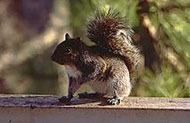
Gray squirrels are common in urban habitats.
Poor landscaping practices cause problems for wildlife. Most suburban landscapes are designed to be attractive to people and to suit their lifestyles. Generally, wildlife habitat needs are not considered. Suburban, manicured landscapes often lack the plant diversity and complex vegetation structure important to wildlife. The typical suburban yard is a grass lawn with a few plants representing only two or three species, most of which are non-native. These landscapes offer poor quality wildlife habitat and harbor only the most common wildlife species such as the American robin, northern mockingbird, gray squirrel, and the common buckeye butterfly.
Here are several examples of typical landscaping practices that are BAD for wildlife.
Poor Plant Selection
• Choosing non-natives over natives. When attempting to improve their landscape for wildlife, homeowners often choose non-native plants. Although some non-native plants may benefit birds and butterflies, others may become invasive, harming native animals in the long term. Further, non-native plants often do not meet the nutritional requirements of wildlife as well as native plants. Native plants are better.
• Not considering plant needs. Often, the soil types, moisture regimes, and light conditions available within a landscape are not considered when choosing plants. For example, installation of sun-loving plants under the heavy shade of a tree canopy or moisture-loving plants on a droughty ridge will lead to planting failure. Make sure to put the right native plant in the right place.
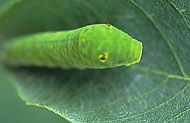
A tiger swallowtail caterpillar feeds on a variety of native host plants.
• Not considering specific wildlife needs. Usually, the life requirements of target wildlife species are not considered when choosing plants. For example, gardeners often include only nectar-bearing plants in their yards when managing for butterflies. However, caterpillar host plants also should be available to provide for the entire butterfly life cycle. Know what native plants your target species really need.
Poor Establishment Practices
• Soil is not properly prepared before planting. Urban soils often are compacted and have low organic matter content making them difficult places for plants to become established and grow. Improper soil preparation may lead to planting failure. To minimize failure, collect a small soil sample from your yard and have it tested for nutrient content. Specific recommendations from the test will help you properly amend your soil before planting. Contact your local Cooperative Extension office for instructions on this free service. Test and prepare your soil first.
• Plants are planted too deep. Planting too deep can cause oxygen deficiency in the root system. Make sure the root ball of a shrub or tree is level with the existing grade and the root collar (where the tree trunk flares out into the roots) is above the soil. Most of the roots of a newly planted tree will develop within the top 12 inches of soil. If the flare of the root collar cannot be seen, it is recommended the excess soil be removed from the root ball. Make sure you can see the root collar.
• Plants are over-mulched. Too much mulch (called mulch volcanoes) can decrease oxygen circulation and increase moisture in the soil, eventually leading to root death. Spread 2-4 inches of mulch over the entire planting area.
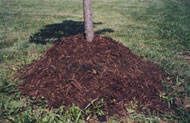
Mulch volcano can damage trees and shrubs.
• Mulch is piled around the trunk or base of plants. This can lead to increased moisture resulting in fungal growth, disease, and insect problems. Keep mulch a few inches away from tree trunks.
• The planting hole is backfilled with amended soil. Amending the soil only within the planting hole creates a bowl effect where the roots don’t extend outside the planting hole, causing girdling of roots. Use the same soil removed from the site.
• Plants are not allowed growing space. Large-maturing trees and shrubs should be planted where they will not interfere with overhead utilities or crowd homes or other structures. Shrubs and trees should be planted at least 6 feet away from all structures.
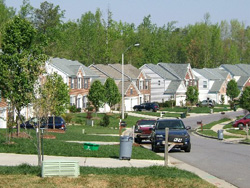
New neighborhoods are landscaped with symmetrical plantings of a few species.
Specimen Planting
Spaced out, symmetrical plantings (or “specimen plantings”) have become the norm for landscapes in new suburban neighborhoods. The fragmented nature of plantings in these landscapes causes animals to move frequently as they search for food and cover. Too much movement exposes birds, butterflies, and other wildlife to predators and causes them to use a lot of the energy they need for survival. Cluster native plants together.
Low Plant Diversity
Most suburban landscapes include only a few common plant species like crape myrtle, Bradford pear, and red maple. Landscapes that lack plant diversity do not provide year-round food and cover for wildlife. Plant a wide variety of native plants.
Low Vertical Structure
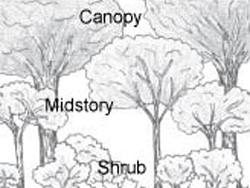
Vertical structure provides habitat for a variety of birds.
Landscapes that do not include short and tall plants within the same general area lack the vertical vegetation structure that allows ground-dwelling, shrub-dwelling, and treetop birds to exist in the same horizontal space. Use native plants of varying heights.
Neat and Green
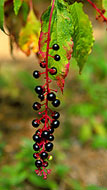 Mowing, pruning, edging, weeding, and applying pesticides may lower the quality of your yard as habitat by removing food and cover. Birds and other wildlife prefer an untidy habitat. However, local ordinances, the opinion of neighbors, or your own need for a neat and green yard may prevent you from allowing your yard to look untidy. In this case, you might consider locating the more wild-looking plants like brambles, vines, un-mowed grasses, or large weedy plants like pokeweed (Phytolacca americana) in a hidden portion of your yard. Avoid the use of pesticides when possible and have a wild spot in your yard.
Mowing, pruning, edging, weeding, and applying pesticides may lower the quality of your yard as habitat by removing food and cover. Birds and other wildlife prefer an untidy habitat. However, local ordinances, the opinion of neighbors, or your own need for a neat and green yard may prevent you from allowing your yard to look untidy. In this case, you might consider locating the more wild-looking plants like brambles, vines, un-mowed grasses, or large weedy plants like pokeweed (Phytolacca americana) in a hidden portion of your yard. Avoid the use of pesticides when possible and have a wild spot in your yard.
Pruning During Nesting Season
In the Southeast, the songbird nesting season generally lasts from mid-March through the end of July. Pruning activities during this period might damage existing nests or expose them to predators. Don’t prune plants during the nesting season.


